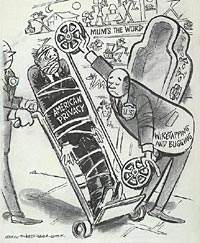

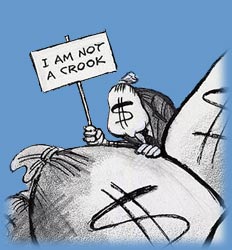 On
the night of June 17, 1972, former employees of the Nixon reelection campaign
broke into the Democratic headquarters in the Watergate building. This
incident began the unraveling of the Nixon Administration's abuses of
power and illegal actions and the administration's efforts to cover up
these activities. Two days after the break-in, Herb Block drew cartoons
of Nixon and his attorney general feigning surprise, and saying, "Who
would think of doing such a thing?" This was followed by one of Nixon
and Department of Justice officials saying, "Remember, we don't talk
until we get a lawyer." He also did a cartoon showing scandal footsteps
leading to the White House. Says Herb Block: "Watergate was not
even the first by the Nixon ‘plumbers.' They had previously broken
into the office of Daniel Ellsberg's psychiatrist. And in the Nixon tapes,
he [Nixon] tells aides how to break into such places as the IRS offices."
In 1974, Herb Block produced Herblock Special Report, a book
of cartoons and text devoted to Nixon's political activities from the
1940s to his resignation in 1974.
On
the night of June 17, 1972, former employees of the Nixon reelection campaign
broke into the Democratic headquarters in the Watergate building. This
incident began the unraveling of the Nixon Administration's abuses of
power and illegal actions and the administration's efforts to cover up
these activities. Two days after the break-in, Herb Block drew cartoons
of Nixon and his attorney general feigning surprise, and saying, "Who
would think of doing such a thing?" This was followed by one of Nixon
and Department of Justice officials saying, "Remember, we don't talk
until we get a lawyer." He also did a cartoon showing scandal footsteps
leading to the White House. Says Herb Block: "Watergate was not
even the first by the Nixon ‘plumbers.' They had previously broken
into the office of Daniel Ellsberg's psychiatrist. And in the Nixon tapes,
he [Nixon] tells aides how to break into such places as the IRS offices."
In 1974, Herb Block produced Herblock Special Report, a book
of cartoons and text devoted to Nixon's political activities from the
1940s to his resignation in 1974.
TapedLong before the Watergate scandals, Herb Block was pointing out excessive use of government power to wiretap or otherwise investigate the activities of citizens an administration felt were at odds with its policies. In 1970, the Civil Service Commission admitted to having a Security Investigations Index with over 10 million entries, and the armed forces revealed surveillance of Americans involved in anti-Vietnam war activities. Taped,
January 18, 1970 |
|
|
|
|
New figure on the American sceneOn June 13, 1971, the New York Times began publishing installments of the "Pentagon Papers," documents about American involvement in Indochina from the end of World War II to the mid 1960s. The Nixon administration moved to block further publication of the papers, and Attorney General John Mitchell obtained a temporary injunction against The New York Times. The Washington Post then released two installments before being similarly enjoined. Other papers picked up the series, until June 30, when the Supreme Court rejected the government's request for a permanent injunction. The "New Figure" cartoon was one of many depicting President Richard Nixon's attempts to curb public information, partly through government control of broadcast stations owned by newspapers. New figure
on the American scene, June 20, 1971 Reproduction of
original drawing |
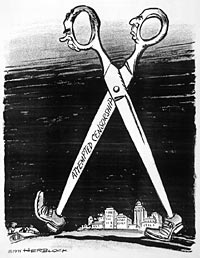 |
|
|
|
For the championship of the United StatesCampaign finance spending soared in the 1960s. The cost of the 1968 presidential campaign was $300 million — almost double that of 1964. With Republican coffers in 1971 comfortably filled while the Democrats were some $9 million in debt, the Democratic-controlled Congress considered proposals to provide public financing. But President Richard Nixon threatened a veto. Eventually, they compromised on some public financing of presidential elections starting in 1976. Since then, loopholes in the laws have permitted almost unlimited political spending far in excess of the government's contributions and of all previous campaigns. In the year 2000 campaign, more than $300 million had already been spent on political ads alone before the end of September. For the championship
of the United States, November 17, 1971 |
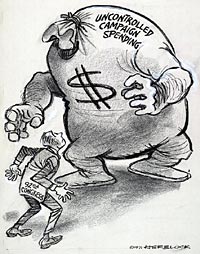 |
|
|
|
"Now, as I was saying four years ago–"In his 1968 bid for the presidency, Richard Nixon announced to the war-weary country that he had a secret plan to end the Vietnam War. When he ran for re-election four years later, American troops were still fighting in Indochina, with casualties continuing to climb. "Now, as I was
saying four years ago–", August 9, 1972 |
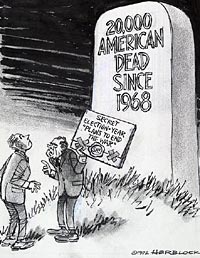 |
|
|
|
"There's no need for an independent investigation–We have everything well in hand"As the 1972 presidential campaign progressed, reports surfaced of violations of campaign regulations and laws. On August 26, the General Accounting Office said that it had found irregularities in reports by the Republican Committee to Re-elect the President (known by the acronym CREEP). Democrats complained that an investigation by the Justice Department and the White House were insufficient and called for a special team to handle the matter. "There's no
need for an independent investigation–We have everything well in
hand," September 8, 1972 |
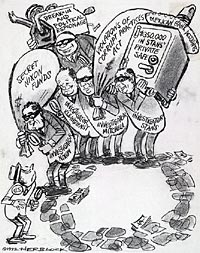 |
|
|
|
Nixon awash in his officeBy June 1973, the country had become transfixed by the investigation of Watergate via the televised hearings of the Senate Select Committee on Presidential Campaign Activities. On June 25, former presidential counsel John Dean began his testimony, the first before the committee to directly accuse President Richard Nixon of involvement in the coverup. [Nixon awash
in his office], June 26, 1973 |
![Image of Herblock's [Nixon awash in his office]](images/s03471u-th.jpg)
|
|
|
|
"Move over – We can't stay in a holding pattern forever"Before the Watergate case, Herb Block had noted other Richard Nixon scandals. These concerned reports of improper influence by ITT Corp. on the location of the future Republican National Convention; Nixon's fluctuating decisions on milk price supports that amounted to a shakedown for campaign funds; and pressures on other businesses to meet quota "suggestions" on contributions. There were disclosures of taxpayer money spent to fix up Nixon's homes in Key Biscayne and San Clemente. Nixon also took large backdated tax deductions for the gift of his vice-presidential papers, which even included newspaper clippings. "Move over –
We can't stay in a holding pattern forever,"
July 29, 1973 |
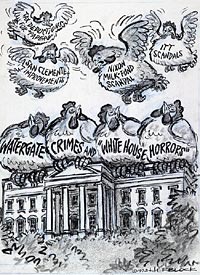 |
|
|
|
Nixon, with sign, "I am not a crook"On November 17, 1973, President Richard Nixon told 400 Associated Press managing editors that he had not profited from public service. "I have earned every cent. And in all of my years in public life I have never obstructed justice. People have got to know whether or not their president is a crook. Well, I'm not a crook," he declared. On April 3, 1974, the White House announced that Nixon would pay $432,787.13 in back taxes plus interest after an investigation by the Internal Revenue Service and a congressional committee. Among Nixon's benefits to himself were improvements in his properties, supposedly necessary for his protection. These included a security ice maker, a security swimming pool heater, security club chairs and table lamps, security sofa and security pillows. [Nixon, with
a money-bag for a face, carries a sign, "I am not a crook"],
April 4, 1974 |
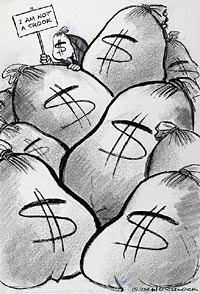 |
|
|
|
Nixon hanging between the tapesEven more damning than President Richard Nixon's profiting from public office were the disclosures of his corruption and attempts at corruption of the government itself including the CIA, the FBI, the Pentagon and even the Secret Service. A taping system that had recorded most of President Nixon's conversations in the Oval Office provided the "smoking gun" that spoke of crime and corruption. Nixon refused to release the tapes until the Supreme Court ordered him to do so. [Nixon hanging
between the tapes], May 24, 1974 Reproduction of original
drawing |
![Image of Herblock's [Nixon hanging between the tapes]](images/hblock11-th.jpg) |
|
|
|
Nixon, "unindicted co-conspirator"By July 14, 1974, President Richard Nixon stood almost alone. His vice-president Spiro Agnew, pleaded nolo contendere to a charge of tax evasion, and was forced to resign. Many of Nixon's closest aides had been convicted of illegal activities. Nixon himself was named an "un-indicted co-conspirator" by the Watergate grand jury. A few days later, the House Judiciary Committee recommended impeachment, and the Supreme Court required him to turn over all subpoenaed tapes. When even his closest friends, reviewing these tapes, agreed that the evidence against him was overwhelming, Nixon bowed to the inevitable, resigning on August 9. [Nixon, "unindicted
co-conspirator"], July 14, 1974 Reproduction of original
drawing |
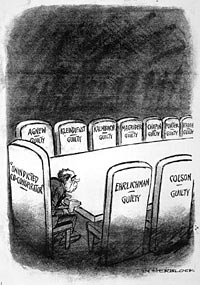 |
Library of Congress Help Desk ( January 15, 2002 )
